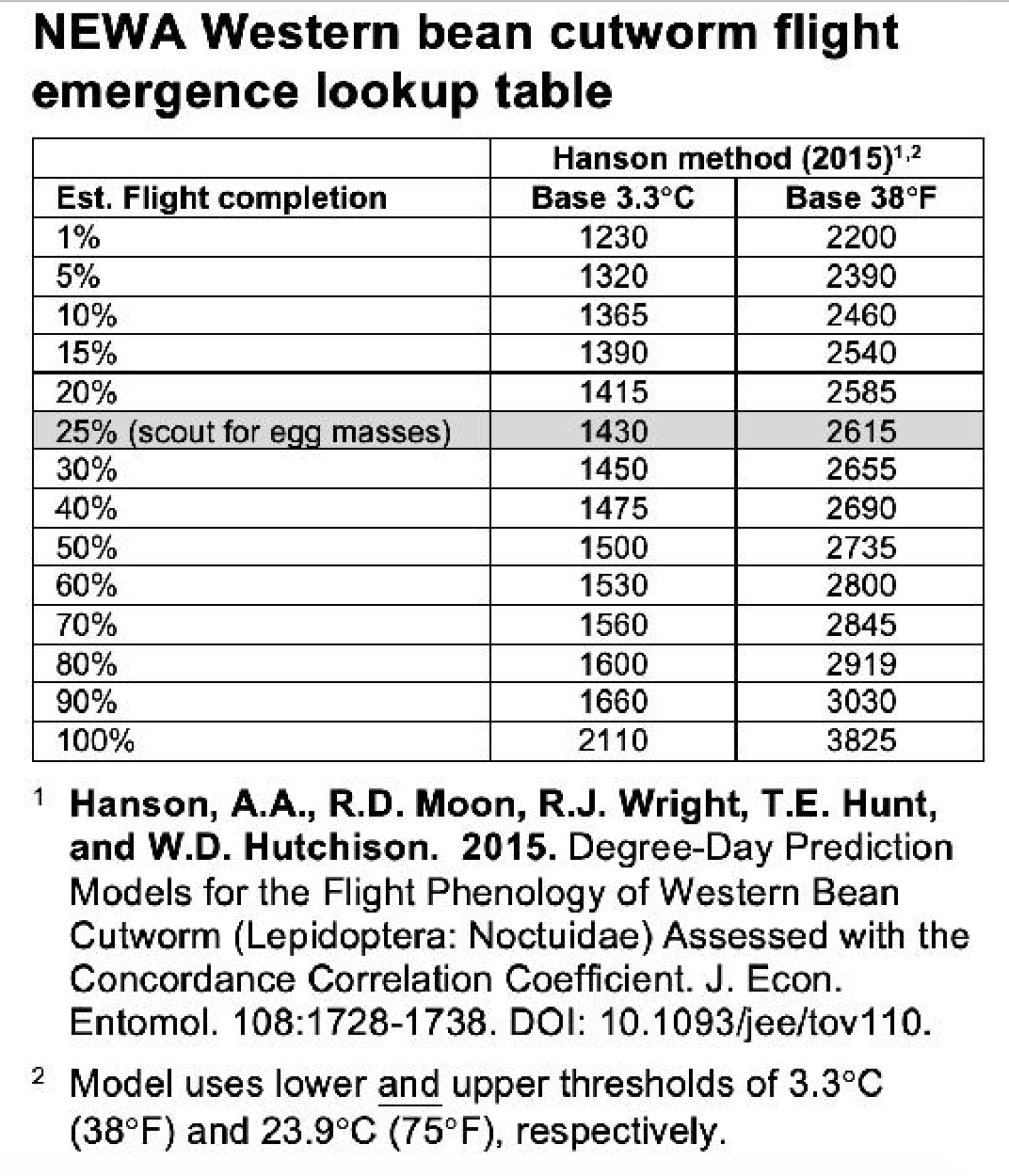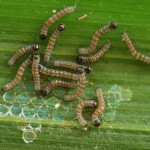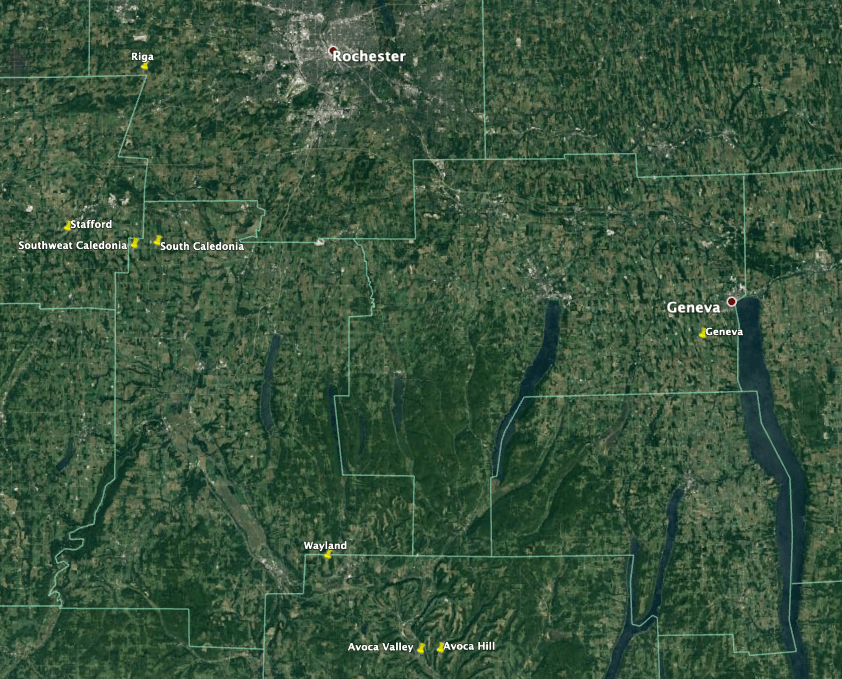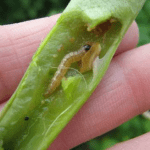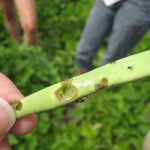Only twenty-seven sites reported this week. Nine of the sites had European corn borer (ECB)-E and eight sites had ECB-Z. Fifteen sites reported corn earworm (CEW) with thirteen high enough to be on a 4, 5 or 6 day spray interval (see table at bottom of post). Fall armyworm (FAW) was caught at fourteen sites and Western bean cutworm (WBC) was caught at twenty-six sites with a high count of 316 in Plattsburgh. The hybrid ECB moth was caught at three of the six reporting sites.
Based on the table below some sites are still near 15% estimated flight completion for WBC while others are near 90% flight completion based on Hanson et al. model.
WBC are most attracted to pretassel corn. Make sure to scout all pretassel fields for egg masses and larvae. After the eggs hatch larvae will first feed in the tassel before making their way to the ears. Be sure to scout fields that are in whorl or early tassel stage for WBC egg masses, with a 4% threshold for processing sweet corn and a 1% threshold for fresh market sweet corn. It takes between 5-7 days WBC eggs to hatch. It is critical that sprays are timed before the larvae have a chance to enter the ear. The egg mass will become purple in color approximately 24 hours before egg hatch. Here is a video from Purdue on scouting for WBC egg masses and larvae.
- WBC egg mass.
- WBC eggs become purple prior to hatch. Photo: Marlin Rice
- WBC larvae just after hatching Photo: Tom Cowan
- Later instar WBC larva, note the two dark bands behind the head capsule. Frank Peairs, Colorado State University
| Location | ECB-E | ECB-Z | Hybrid | CEW | FAW | WBC | DD | |
| Western NY trap Catch |
||||||||
| Attica (Wyoming Co.) | 0 | 0 | NA | 0 | 0 | 7 | 2857 | |
| Baldwinsville (Onondaga Co.) | 1 | 0 | NA | 10 | 3 | 11 | 2974 | |
| Batavia (Genesee Co.) | 0 | 1 | NA | 8 | 0 | 41 | 2922 | |
| Bellona (Yates Co.)* | 0 | 2 | 2 | 1 | 3 | 72 | 2948 | |
| Brockport (Monroe Co.) | 0 | 0 | NA | 0 | 0 | 5 | 2887 | |
| Eden (Erie Co.) | 0 | 0 | NA | 11 | 37 | 52 | 2929 | |
| Farmington (Ontario Co)* | 0 | 0 | 0 | 0 | 0 | 1 | 3022 | |
| Geneva (Ontario Co.)* | 0 | 3 | 2 | 8 | 35 | 14 | 2956 | |
| Hamlin (Orleans Co.) | 0 | 1 | NA | 5 | 0 | 9 | 2920 | |
| Kennedy (Chautauqua Co.) | NA | NA | NA | NA | NA | NA | 2776 | |
| King Ferry (Cayuga Co.) | NA | NA | NA | NA | NA | NA | 2811 | |
| Kirkville (Madison Co.) | NA | NA | NA | NA | NA | NA | 2920 | |
| LeRoy (Genesee Co.) | 7 | 3 | NA | 5 | 4 | 7 | 2905 | |
| Lyndonville (Orleans Co.) | 0 | 0 | NA | 0 | 2 | 129 | 2845 | |
| Oswego (Oswego Co.) | 0 | 0 | NA | 0 | 0 | 62 | 2743 | |
| Panama (Chautauqua Co.) | 0 | 13 | NA | 3 | 0 | 0 | 2605 | |
| Penn Yan (Yates Co.)* | 0 | 0 | 0 | 2 | 3 | 4 | 2854 | |
| Portville (Cattaraugus Co.) | 0 | 0 | NA | 0 | 0 | 6 | 2578 | |
| Preble (Cortland Co.) | 0 | 0 | NA | 0 | 0 | 23 | 2516 | |
| Ransomville (Niagara Co.) | 0 | 0 | NA | 4 | 9 | 11 | 2957 | |
| Seneca Castle (Ontario Co.)* | 1 | 0 | 2 | 0 | 0 | 5 | 2894 | |
| Sherwood (Cayuga Co.) | NA | NA | NA | NA | NA | NA | 2850 | |
| Williamson (Wayne Co.) | NA | NA | NA | NA | NA | NA | 2745 | |
| Eastern NY trap Catch |
||||||||
| Amsterdam (Fulton Co.) | NA | NA | NA | NA | NA | NA | 2778 | |
| Feura Bush (Albany Co.) | 0 | 2 | NA | NA | 0 | 1 | 3067 | |
| Florida (Orange Co.) | 1 | 0 | NA | 36 | 71 | 3 | 3195 | |
| Greenwich (Washington Co.) | NA | NA | NA | NA | NA | NA | 2980 | |
| Hurley (Ulster Co.)* | 13 | 0 | 0 | 12 | 5 | 6 | 3076 | |
| Kinderhook (Columbia Co.) | 2 | 0 | NA | 8 | 5 | 10 | 3092 | |
| Melrose (Rensselear Co.) | NA | NA | NA | NA | NA | NA | 3012 | |
| Middleburgh (Schoharie Co.) | NA | NA | NA | NA | NA | NA | 3072 | |
| New Paltz (Ulster Co.) | NA | NA | NA | NA | NA | NA | 3247 | |
| Peru (Clinton Co.) | 1 | 0 | NA | 0 | 4 | 172 | 2823 | |
| Plattsburgh (Clinton Co.) | 2 | 0 | NA | 0 | 0 | 316 | 2877 | |
| Plessis (Jefferson Co.) | 0 | 1 | NA | 1 | 6 | 148 | 2939 | |
| South Colton (St. Lawrence Co.) | NA | NA | NA | NA | NA | NA | 2573 | |
| Stone Ridge (Ulster Co.) | NA | NA | NA | NA | NA | NA | 3004 | |
| Ticonderoga (Essex Co.) | 1 | 0 | NA | 0 | 0 | 104 | 2876 | |
| Tivoli (Dutchess Co.) | NA | NA | NA | NA | NA | NA | 3215 | |
| Unadilla (Delaware Co.) | 0 | 0 | NA | 12 | 3 | 46 | 2526 | |
| ECB – European Corn Borer CEW – Corn Earworm FAW – Fall Armyworm WBC – Western Bean Cutworm NA – not available DD – Degree Day (base 38) March 1st accumulation Climate Smart Farming |
||||||||
| trap catches for the week of 7.28.20 – 8.4.20 |
||||||||
Dry Bean Western Bean Cutworm Alert
8.4.20
Marion Zuefle, NYS IPM Program and Margie Lund, CVP
(Information and photos from T. Baute, OMAFRA)
This year we are monitoring eight WBC traps placed next to dry bean fields. The location of the traps are given in the image below. Dry bean growers should scout adjacent corn for WBC eggs and larvae when cumulative trap catch reaches 50 moths. This week all eight sites we are monitoring reached the 50 moth threshold. Peak WBC flight historically occurs the last week of July into early August. All dry bean growers should begin scouting pods for WBC feeding about 10 days after peak flight regardless of cumulative trap catch, and should continue to scout for three weeks, especially if damage has been seen in recent years. WBC lays eggs on pretassling corn, but if corn is already passed the tassel stage they will begin to lay eggs on dry beans.
WBC eggs, laid shortly after moth emergence, take 5-7 days to hatch. Pod feeding typically begins 10 days after peak moth catch. Early feeding by small larvae is generally minor and does not go into the pod. Growers in areas of concern should scout bean pin pods and larger pods for damage/feeding holes.
Check 10 random spots in a field, 5 plants per spot. Inspect all the pods on the plants looking for holes. Surface feeding can be caused by other insects. WBC will mine directly into the pod and will often feed on the seed inside. European corn borer will also feed inside the pod and would most likely still be present (see image below). Slugs will also feed on the pods causing similar damage, but will often leave a slime trail (image below). If there is damage going directly into the pod and seed but no larva present, it is quite possibly WBC. During the day WBC larva are not actively feeding in the pod, instead they drop to the soil and will remain there until night. Fresh damage will be green, not brown.
- Early damage made by small WBC larvae.
- ECB in pod.
- Damage caused by slug feeding, note slime trail.
- Later feeding damage going through pod and into beans.
| Dry Bean Location | 7.7.20 | 7.14.20 | 7.21.20 | 7.28.20 | 8.4.20 | Cumulative WBC | |
| Avoca Hill (Steuben Co.) | 0 | 0 | 23 | 67 | 80 | 170 | |
| Avoca Valley (Steuben Co.) | 1 | 0 | 6 | 44 | 94 | 145 | |
| Caledonia South (Livingston Co.) | 0 | 0 | 6 | 54 | 58 | 118 | |
| Caledonia Southwest (Livingston Co.) | 0 | 0 | 8 | 100 | 101 | 209 | |
| Geneva (Ontario Co.) | 0 | 2 | 13 | 38 | 42 | 53 | |
| Riga (Monroe Co.) | 0 | 1 | 24 | 49 | 28 | 102 | |
| Stafford (Genesee Co.) | 1 | 1 | 18 | 41 | 34 | 95 | |
| Wayland (Steuben Co.) | 0 | 2 | 4 | 24 | 92 | 122 | |
| Western Bean Cutworm trap counts by date. | |||||||
This project is funded by the NYS Dry Bean Industry.

